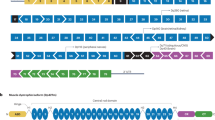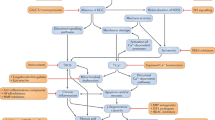Abstract
The muscular dystrophies are commonly associated with cardiovascular complications, including cardiomyopathy and cardiac arrhythmias. These complications are caused by intrinsic defects in cardiomyocyte and cardiac conduction system function, and by the presence of severe skeletal muscle disease, which also contributes to cardiac dysfunction. Unlike the skeletal muscle degenerative process, for which treatment options are currently limited, therapy is available for the cardiovascular complications that accompany muscular dystrophy. New therapies for skeletal muscle degeneration are moving into clinical trials and, ultimately, into clinical practice. These therapies are expected to also improve the cardiac function, longevity and wellbeing of muscular dystrophy patients.
This is a preview of subscription content, access via your institution
Access options
Subscribe to this journal
Receive 12 print issues and online access
$209.00 per year
only $17.42 per issue
Buy this article
- Purchase on Springer Link
- Instant access to full article PDF
Prices may be subject to local taxes which are calculated during checkout


Similar content being viewed by others
References
Laval SH and Bushby KM (2004) Limb-girdle muscular dystrophies—from genetics to molecular pathology. Neuropathol Appl Neurobiol 30: 91–105
Lapidos KA et al. (2004) The dystrophin glycoprotein complex: signaling strength and integrity for the sarcolemma. Circ Res 94: 1023–1031
Blake DJ and Martin-Rendon E (2002) Intermediate filaments and the function of the dystrophin-protein complex. Trends Cardiovasc Med 12: 224–228
Petrof BJ et al. (1993) Dystrophin protects the sarcolemma from stresses developed during muscle contraction. Proc Natl Acad Sci U S A 90: 3710–3714
Danialou G et al. (2001) Dystrophin-deficient cardiomyocytes are abnormally vulnerable to mechanical stress-induced contractile failure and injury. Faseb J 15: 1655–1657
Dellorusso C et al. (2001) Tibialis anterior muscles in mdx mice are highly susceptible to contraction-induced injury. J Muscle Res Cell Motil 22: 467–475
Hack AA et al. (1999) Muscle degeneration without mechanical injury in sarcoglycan deficiency. Proc Natl Acad Sci U S A 96: 10723–10728
Badorff C et al. (2000) Enteroviral protease 2A directly cleaves dystrophin and is inhibited by a dystrophin-based substrate analogue. J Biol Chem 275: 11191–11197
Matsuda R et al. (1995) Visualization of dystrophic muscle fibers in mdx mouse by vital staining with Evans blue: evidence of apoptosis in dystrophin-deficient muscle. J Biochem (Tokyo) 118: 959–964
McLaurin MD et al. (1997) Cardiac troponin I, cardiac troponin T, and creatine kinase MB in dialysis patients without ischemic heart disease: evidence of cardiac troponin T expression in skeletal muscle. Clin Chem 43: 976–982
Saggin L et al. (1990) Cardiac troponin T in developing, regenerating and denervated rat skeletal muscle. Development 110: 547–554
Porter JD et al. (2002) A chronic inflammatory response dominates the skeletal muscle molecular signature in dystrophin-deficient mdx mice. Hum Mol Genet 11: 263–272
Wehling-Henricks M et al. (2004) Prednisolone decreases cellular adhesion molecules required for inflammatory cell infiltration in dystrophin-deficient skeletal muscle. Neuromuscul Disord 14: 483–490
Thomas GD et al. (1998) Impaired metabolic modulation of alpha-adrenergic vasoconstriction in dystrophin-deficient skeletal muscle. Proc Natl Acad Sci U S A 95: 15090–15095
Sander M et al. (2000) Functional muscle ischemia in neuronal nitric oxide synthase-deficient skeletal muscle of children with Duchenne muscular dystrophy. Proc Natl Acad Sci U S A 97: 13818–13823
Coral-Vazquez R et al. (1999) Disruption of the sarcoglycan-sarcospan complex in vascular smooth muscle: a novel mechanism for cardiomyopathy and muscular dystrophy. Cell 98: 465–474
Wheeler MT et al. (2004) Smooth muscle cell-extrinsic vascular spasm arises from cardiomyocyte degeneration in sarcoglycan-deficient cardiomyopathy. J Clin Invest 113: 668–675
Moreira ES et al. (2000) Limb-girdle muscular dystrophy type 2G is caused by mutations in the gene encoding the sarcomeric protein telethonin. Nat Genet 24: 163–166
Hauser MA et al. (2000) Myotilin is mutated in limb girdle muscular dystrophy 1A. Hum Mol Genet 9: 2141–2147
Hackman P et al. (2002) Tibial muscular dystrophy is a titinopathy caused by mutations in TTN, the gene encoding the giant skeletal-muscle protein titin. Am J Hum Genet 71: 492–500
Knoll R et al. (2002) The cardiac mechanical stretch sensor machinery involves a Z disc complex that is defective in a subset of human dilated cardiomyopathy. Cell 111: 943–955
Omens JH et al. (2002) Muscle LIM protein deficiency leads to alterations in passive ventricular mechanics. Am J Physiol Heart Circ Physiol 282: H680–H687
Arber S et al. (1997) MLP-deficient mice exhibit a disruption of cardiac cytoarchitectural organization, dilated cardiomyopathy, and heart failure. Cell 88: 393–403
Muntoni F et al. (2004) Defective glycosylation in congenital muscular dystrophies. Curr Opin Neurol 17: 205–209
Brockington M et al. (2001) Mutations in the fukutin-related protein gene (FKRP) identify limb girdle muscular dystrophy 2I as a milder allelic variant of congenital muscular dystrophy MDC1C. Hum Mol Genet 10: 2851–2859
Barresi R et al. (2004) LARGE can functionally bypass alpha-dystroglycan glycosylation defects in distinct congenital muscular dystrophies. Nat Med 10: 696–703
Ostlund C and Worman HJ (2003) Nuclear envelope proteins and neuromuscular diseases. Muscle Nerve 27: 393–406
van Berlo JH et al. (2005) Meta-analysis of clinical characteristics of 299 carriers of LMNA gene mutations: do lamin A/C mutations portend a high risk of sudden death? J Mol Med 83: 79–83
Bashir R et al. (1998) A gene related to Caenorhabditis elegans spermatogenesis factor fer-1 is mutated in limb-girdle muscular dystrophy type 2B. Nat Genet 20: 37–42
Anderson LV et al. (1999) Dysferlin is a plasma membrane protein and is expressed early in human development. Hum Mol Genet 8: 855–861
Davis DB et al. (2002) Calcium-sensitive phospholipid binding properties of normal and mutant ferlin C2 domains. J Biol Chem 277: 22883–22888
Liu J et al. (1998) Dysferlin, a novel skeletal muscle gene, is mutated in Miyoshi myopathy and limb girdle muscular dystrophy. Nat Genet 20: 31–36
Bansal D et al. (2003) Defective membrane repair in dysferlin-deficient muscular dystrophy. Nature 423: 168–172
Fanin M et al. (2001) Calpain-3 and dysferlin protein screening in patients with limb-girdle dystrophy and myopathy. Neurology 56: 660–665
Matsuda C et al. (2001) The sarcolemmal proteins dysferlin and caveolin-3 interact in skeletal muscle. Hum Mol Genet 10: 1761–1766
Woodman SE et al. (2004) Caveolinopathies: mutations in caveolin-3 cause four distinct autosomal dominant muscle diseases. Neurology 62: 538–543
Bushby K et al. (2003) 107th ENMC international workshop: the management of cardiac involvement in muscular dystrophy and myotonic dystrophy. 7th–9th June 2002, Naarden, the Netherlands. Neuromuscul Disord 13: 166–172
Muntoni F (2003) Cardiomyopathy in muscular dystrophies. Curr Opin Neurol 16: 577–583
McGeachie JK and Grounds MD (1999) The timing between skeletal muscle myoblast replication and fusion into myotubes, and the stability of regenerated dystrophic myofibres: an autoradiographic study in mdx mice. J Anat 194: 287–295
Manasek FJ (1968) Mitosis in developing cardiac muscle. J Cell Biol 37: 191–196
Beltrami AP et al. (2003) Adult cardiac stem cells are multipotent and support myocardial regeneration. Cell 114: 763–776
Hunt SA et al. (2001) ACC/AHA Guidelines for the Evaluation and Management of Chronic Heart Failure in the Adult: Executive Summary A Report of the American College of Cardiology/American Heart Association Task Force on Practice Guidelines (Committee to Revise the 1995 Guidelines for the Evaluation and Management of Heart Failure): Developed in Collaboration With the International Society for Heart and Lung Transplantation; Endorsed by the Heart Failure Society of America. Circulation 104: 2996–3007
Duboc D et al. (2005) Effect of perindopril on the onset and progression of left ventricular dysfunction in Duchenne muscular dystrophy. J Am Coll Cardiol 45: 855–857
Melacini P et al. (1998) Cardiac transplantation in a Duchenne muscular dystrophy carrier. Neuromuscul Disord 8: 585–590
Rees W et al. (1993) Heart transplantation in patients with muscular dystrophy associated with end-stage cardiomyopathy. J Heart Lung Transplant 12: 804–807
Corrado G et al. (2002) Prognostic value of electrocardiograms, ventricular late potentials, ventricular arrhythmias, and left ventricular systolic dysfunction in patients with Duchenne muscular dystrophy. Am J Cardiol 89: 838–841
Groh WJ et al. (2002) Severity of cardiac conduction involvement and arrhythmias in myotonic dystrophy type 1 correlates with age and CTG repeat length. J Cardiovasc Electrophysiol 13: 444–448
Ranum LP and Day JW (2002) Myotonic dystrophy: clinical and molecular parallels between myotonic dystrophy type 1 and type 2. Curr Neurol Neurosci Rep 2: 465–470
Schoser BG et al. (2004) Sudden cardiac death in myotonic dystrophy type 2. Neurology 63: 2402–2404
Gregoratos G et al. (2002) ACC/AHA/NASPE 2002 guideline update for implantation of cardiac pacemakers and antiarrhythmia devices: summary article. A report of the American College of Cardiology/American Heart Association Task Force on Practice Guidelines (ACC/AHA/NASPE Committee to Update the 1998 Pacemaker Guidelines). J Cardiovasc Electrophysiol 13: 1183–1199
Finder JD et al. (2004) Respiratory care of the patient with Duchenne muscular dystrophy: ATS consensus statement. Am J Respir Crit Care Med 170: 456–465
Gregorevic P et al. (2004) Systemic delivery of genes to striated muscles using adeno-associated viral vectors. Nat Med 10: 828–834
Gussoni E et al. (1999) Dystrophin expression in the mdx mouse restored by stem cell transplantation. Nature 401: 390–394
LaBarge MA and Blau HM (2002) Biological progression from adult bone marrow to mononucleate muscle stem cell to multinucleate muscle fiber in response to injury. Cell 111: 589–601
Barton ER et al. (2002) Muscle-specific expression of insulin-like growth factor I counters muscle decline in mdx mice. J Cell Biol 157: 137–148
Bogdanovich S et al. (2002) Functional improvement of dystrophic muscle by myostatin blockade. Nature 420: 418–421
Krag TO et al. (2004) Heregulin ameliorates the dystrophic phenotype in mdx mice. Proc Natl Acad Sci U S A 101: 13856–13860
Acknowledgements
EMM is supported by the Muscular Dystrophy Association, the NIH and the Burroughs Wellcome Fund.
Author information
Authors and Affiliations
Corresponding author
Ethics declarations
Competing interests
The authors declare no competing financial interests.
Glossary
- DYSTROPHIN–GLYCOPROTEIN COMPLEX
-
A macromolecular complex important for membrane stability and interactions with the extracellular matrix
- SARCOGLYCAN
-
The sarcoglycan subunits α, β, γ and δ are part of the dystrophin–glycoprotein complex
- TELETHONIN
-
Mutations in telethonin lead to muscular dystrophy; together with titin, telethonin is thought to be important for passive stretch in cardiomyocytes
- TITIN
-
A giant protein that spans the length of the sarcomere and is thought to be important for elastic recoil of muscle
- MYOTILIN
-
A protein found at the Z band; mutations in myotilin lead to muscular dystrophy
- FUKUTIN RELATED PROTEIN
-
A protein thought to have glyosylation functions that are important for membrane-matrix interactions
- KYPHOSCOLIOSIS
-
A combination of backward (kyphosis) and lateral (scoliosis) curvature of the spinal column
- HEREGULIN
-
An extracellular matrix protein that is involved in neuromuscular junction function
Rights and permissions
About this article
Cite this article
McNally, E., MacLeod, H. Therapy Insight: cardiovascular complications associated with muscular dystrophies. Nat Rev Cardiol 2, 301–308 (2005). https://doi.org/10.1038/ncpcardio0213
Received:
Accepted:
Issue Date:
DOI: https://doi.org/10.1038/ncpcardio0213



